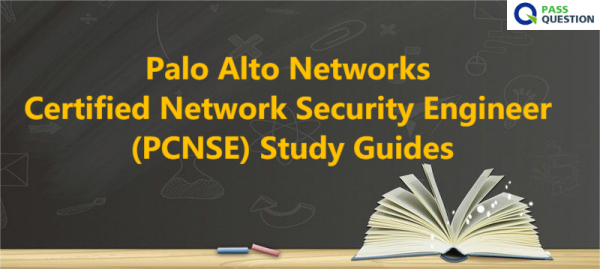Palo Alto Networks Certified Network Security Engineer (PCNSE) Study Guides
If you are interested in pursuing the PCNSE certification, there are a variety of resources available to help you prepare. PassQuestion offers Palo Alto Networks Certified Network Security Engineer (PCNSE) Study Guides to ensure your success.It is important to note that the PCNSE exam is a challenging exam that requires a thorough understanding of the exam content and practical experience working with Palo Alto Networks products. It is recommended to allocate sufficient time for study and preparation.

To become PCNSE certified, you will need to complete the following steps:
- Meet the eligibility requirements: To be eligible for the PCNSE certification, you must have at least six months of experience working with Palo Alto Networks products in a security-related role, such as a network security engineer or security analyst.
- Complete the PCNSE training: The PCNSE certification requires that you complete a training course. This course covers a wide range of topics related to network security, including firewall technologies, network architecture, and security protocols. You can complete the training through an authorized training partner or online through the Palo Alto Networks Learning Center.
- Pass the PCNSE exam:The PCNSE exam is a proctored, multiple-choice exam that covers a wide range of topics related to Palo Alto Networks security platforms. The exam consists of 60 questions and you have 90 minutes to complete it. You will need to score a 70% or higher to pass.
- Renew your certification: The PCNSE certification is valid for three years. To maintain your certification, you will need to complete continuing education requirements, such as taking additional training courses or passing recertification exams.
Overall, becoming PCNSE certified requires a combination of training, experience, and demonstrated proficiency in using Palo Alto Networks products. By following these steps and investing the time and effort necessary to prepare for the certification exam, you can gain the skills and knowledge needed to succeed in a career as a network security engineer.
What is the format of the PCNSE exam?
• Certification Name: Palo Alto Networks Certified Network Security Engineer
• Delivered through Pearson VUE: www.pearsonvue.com/paloaltonetworks
• Exam Series: PCNSE
• Seat Time: 90 minutes
• Total Exam Time: 80 minutes
• Number of items: 65-75
• Format: Multiple Choice, Scenarios with Graphics, and Matching
• Languages: English and Japanese
Which topics does the PCNSE exam cover?
PCNSE is a formal, industry-recognized certification program that validates detailed knowledge of core features and functions of Palo Alto Networks next-generation firewalls. Below are the topics covered on the exam and the weighted percentage of the exam dedicated to each topic:
● Core Concepts 12%
● Deploy and Configure Core Components 20%
● Deploy and Configure Features and Subscriptions 17%
● Deploy and Configure Firewalls Using Panorama 17%
● Manage and Operate 16%
● Troubleshooting 18%
View Online Palo Alto Networks PCNSE Free Questions
1.While analyzing the Traffic log, you see that some entries show "unknown-tcp" in the Application column What best explains these occurrences?
A. A handshake took place, but no data packets were sent prior to the timeout.
B. A handshake took place; however, there were not enough packets to identify the application.
C. A handshake did take place, but the application could not be identified.
D. A handshake did not take place, and the application could not be identified.
Answer: C
2.A network security engineer wants to prevent resource-consumption issues on the firewall.
Which strategy is consistent with decryption best practices to ensure consistent performance?
A. Use RSA in a Decryption profile tor higher-priority and higher-risk traffic, and use less processor-intensive decryption methods for lower-risk traffic
B. Use PFS in a Decryption profile for higher-priority and higher-risk traffic, and use less processor-intensive decryption methods for tower-risk traffic
C. Use Decryption profiles to downgrade processor-intensive ciphers to ciphers that are less processor-intensive
D. Use Decryption profiles to drop traffic that uses processor-intensive ciphers
Answer: B
3.Which statement accurately describes service routes and virtual systems?
A. Virtual systems that do not have specific service routes configured inherit the global service and service route settings for the firewall.
B. Virtual systems can only use one interface for all global service and service routes of the firewall.
C. Virtual systems cannot have dedicated service routes configured; and virtual systems always use the global service and service route settings for the firewall.
D. The interface must be used for traffic to the required external services.
Answer: B
4.What are two best practices for incorporating new and modified App-IDs? (Choose two)
A. Configure a security policy rule to allow new App-lDs that might have network-wide impact
B. Study the release notes and install new App-IDs if they are determined to have low impact
C. Perform a Best Practice Assessment to evaluate the impact or the new or modified App-IDs
D. Run the latest PAN-OS version in a supported release tree to have the best performance for the new App-IDs
Answer: A,B
5.Which CLI command is used to determine how much disk space is allocated to logs?
A. show logging-status
B. show system info
C. debug log-receiver show
D. show system logdfo-quota
Answer: D
- TOP 50 Exam Questions
-
Exam
All copyrights reserved 2025 PassQuestion NETWORK CO.,LIMITED. All Rights Reserved.

